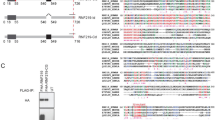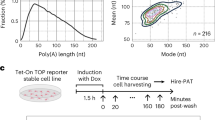Abstract
Deadenylation is the major step in triggering mRNA decay and results in mRNA translation inhibition in eukaryotic cells. Therefore, it is plausible that deadenylation also induces the mRNP remodeling required for formation of GW bodies or RNA processing bodies (P-bodies), which harbor translationally silenced mRNPs. In this chapter, we discuss several examples to illustrate the roles of deadenylation in regulating gene expression. We highlight several lines of evidence indicating that even though non-translatable mRNPs may be prepared and/or assembled into P-bodies in different ways, deadenylation is always a necessary, and perhaps the earliest, step in mRNA decay pathways that enable mRNP remodeling required for P-body formation. Thus, deadenylation and the participating deadenylases are not simply required for preparing mRNA substrates; they play an indispensable role both structurally and functionally in P-body formation and regulation.
Access this chapter
Tax calculation will be finalised at checkout
Purchases are for personal use only
Similar content being viewed by others
References
Andrei MA, Ingelfinger D, Heintzmann R, Achsel T, Rivera-Pomar R, Luhrmann R (2005) A role for eIF4E and eIF4E-transporter in targeting mRNPs to mammalian processing bodies. RNA 11:717–727
Bagga S, Bracht J, Hunter S, Massirer K, Holtz J, Eachus R, Pasquinelli AE (2005) Regulation by let-7 and lin-4 miRNAs results in target mRNA degradation. Cell 122:553–563
Baker EJ (1993) Control of poly(A) length. In: Belasco JG, Brawerman G (eds) Control of messenger RNA stability. Academic, San Diego
Balagopal V, Parker R (2009) Polysomes, P bodies and stress granules: states and fates of eukaryotic mRNAs. Curr Opin Cell Biol 21:403–408
Behm-Ansmant I, Rehwinkel J, Doerks T, Stark A, Bork P, Izaurralde E (2006) mRNA degradation by miRNAs and GW182 requires both CCR4:NOT deadenylase and DCP1:DCP2 decapping complexes. Genes Dev 20:1885–1898
Boeck R, Tarun S Jr, Rieger M, Deardorff JA, Muller-Auer S, Sachs AB (1996) The yeast Pan2 protein is required for poly(A)-binding protein-stimulated poly(A)-nuclease activity. J Biol Chem 271:432–438
Brawerman G (1981) The role of the poly(A) sequence in mammalian messenger RNA. Crit Rev Biochem 10:1–38
Brengues M, Parker R (2007) Accumulation of polyadenylated mRNA, Pab1p, eIF4E, and eIF4G with P-bodies in Saccharomyces cerevisiae. Mol Biol Cell 18:2592–2602
Cao D, Parker R (2001) Computational modeling of eukaryotic mRNA turnover. RNA 7:1192–1212
Chang T-C, Yamashita A, Chen C-YA, Yamashita Y, Zhu W, Durdan S, Kahvejian A, Sonenberg N, Shyu A-B (2004) UNR, a new partner of poly(A)-binding protein, plays a key role in translationally coupled mRNA turnover mediated by the c-fos major coding-region determinant. Genes Dev 18:2010–2023
Chen C-YA, Shyu A-B (2003) Rapid deadenylation triggered by a nonsense codon precedes decay of the RNA body in a mammalian cytoplasmic nonsense-mediated decay pathway. Mol Cell Biol 23:4805–4813
Chen CYA, Shyu AB (2011) Mechanisms of deadenylation-dependent decay. Wiley Interdiscip Rev RNA 2:167–183
Chen CY, Chen TM, Shyu AB (1994) Interplay of two functionally and structurally distinct domains of the c-fos AU-rich element specifies its mRNA-destabilizing function. Mol Cell Biol 14:416–426
Chen J, Chiang Y-C, Denis CL (2002) CCR4, a 3′-5′ poly(A) RNA and ssDNA exonuclease, is the catalytic component of the cytoplasmic deadenylase. EMBO J 21:1414–1426
Chen C-YA, Zheng D, Xia Z, Shyu A-B (2009) Ago-TNRC6 triggers microRNA-mediated decay by promoting two deadenylation steps. Nat Struct Mol Biol 16:1160–1166
Chowdhury A, Tharun S (2008) lsm1 mutations impairing the ability of the Lsm1p-7p-Pat1p complex to preferentially bind to oligoadenylated RNA affect mRNA decay in vivo. RNA 14:2149–2158
Coller J, Parker R (2004) Eukaryotic mRNA decapping. Annu Rev Biochem 74:861–890
Cougot N, Babajko S, Seraphin B (2004) Cytoplasmic foci are sites of mRNA decay in human cells. J Cell Biol 165:31–40
Dupressoir A, Morel A-P, Barbot W, Loireau M-P, Corbo L, Heidmann T (2001) Identification of four families of yCCR4- and Mg2+-dependent endonuclease-related proteins in higher eukaryotes, and characterization of orthologs of yCCR4 with a conserved leucine-rich repeat essential for hCAF1/hPOP2 binding. BMC Genomics 2:9
Eulalio A, Behm-Ansmant I, Izaurralde E (2007a) P bodies: at the crossroads of post-transcriptional pathways. Nat Rev Mol Cell Biol 8:9–22
Eulalio A, Behm-Ansmant I, Schweizer D, Izaurralde E (2007b) P-body formation is a consequence, not the cause, of RNA-mediated gene silencing. Mol Cell Biol 27:3970–3981
Eulalio A, Huntzinger E, Nishihara T, Rehwinkel J, Fauser M, Izaurralde E (2009) Deadenylation is a widespread effect of miRNA regulation. RNA 15:21–32
Eystathioy T, Chan EKL, Tenenbaum SA, Keene JD, Griffith K, Fritzler MJ (2002) A phosphorylated cytoplasmic autoantigen, GW182, associates with a unique population of human mRNAs within novel cytoplasmic speckles. Mol Biol Cell 13:1338–1351
Eystathioy T, Jakymiw A, Chan EKL, Seraphin B, Cougot N, Fritzler MJ (2003) The GW182 protein colocalizes with mRNA degradation associated proteins hDcp1 and hLSm4 in cytoplasmic GW bodies. RNA 9:1171–1173
Fabian MR, Mathonnet G, Sundermeier T, Mathys H, Zipprich JT, Svitkin YV, Rivas F, Jinek M, Wohlschlegel J, Doudna JA, Chen C-YA, Shyu A-B, Yates Iii JR, Hannon GJ, Filipowicz W, Duchaine TF, Sonenberg N (2009) Mammalian miRNA RISC recruits CAF1 and PABP to affect PABP-dependent deadenylation. Mol Cell 35:868–880
Fabian MR, Sonenberg N, Filipowicz W (2010) Regulation of mRNA translation and stability by microRNAs. Annu Rev Biochem 79:351–379
Franks TM, Lykke-Andersen J (2008) The control of mRNA decapping and P-body formation. Mol Cell 32:605–615
Giraldez AJ, Mishima Y, Rihel J, Grocock RJ, Van Dongen S, Inoue K, Enright AJ, Schier AF (2006) Zebrafish MiR-430 promotes deadenylation and clearance of maternal mRNAs. Science 312:75–79
Goldstrohm AC, Wickens M (2008) Multifunctional deadenylase complexes diversify mRNA control. Nat Rev Mol Cell Biol 9:337–344
Grosset C, Chen C-YA XN, Sonenberg N, Jacquemin-Sablon H, Shyu A-B (2000) A mechanism for translationally coupled mRNA turnover: interaction between the poly(A) tail and a c-fos RNA coding determinant via a protein complex. Cell 103:29–40
Iwasaki S, Kawamata T, Tomari Y (2009) Drosophila Argonaute 1 and Argonaute 2 employ distinct mechanisms for translational repression. Mol Cell 34:58–67
Jacobson A (1996) Poly(A) metabolism and translation: the closed-loop Model. In: Hershey JWB, Mathews MB, Sonenberg N (eds) Tanslational control. Cold Spring Harbor Laboratory Press, Plainview, pp 451–480
Jacobson A, Peltz SW (1996) Interrelationships of the pathways of mRNA decay and translation in eukaryotic cells. Annu Rev Biochem 65:693–739
Kedersha N, Anderson P (2007) Mammalian stress granules and processing bodies. Methods Enzymol 431:61–81
Kedersha N, Stoecklin G, Ayodele M, Yacono P, Lykke-Andersen J, Fritzler MJ, Scheuner D, Kaufman RJ, Golan DE, Anderson P (2005) Stress granules and processing bodies are dynamically linked sites of mRNP remodeling. J Cell Biol 169:871–884
Mangus DA, Evans MC, Jacobson A (2003) Poly(A)-binding proteins: multifunctional scaffolds for the post-transcriptional control of gene expression. Genome Biol 4:233
Mangus DA, Evans MC, Agrin NS, Smith M, Gongidi P, Jacobson A (2004) Positive and negative regulation of poly(A) nuclease. Mol Cell Biol 24:5521–5533
Moore MJ (2005) From birth to death: the complex lives of eukaryotic mRNAs. Science 309:1514–1518
Muhlrad D, Parker R (1994) Premature translational termination triggers mRNA decapping. Nature 370:578–581
Parker R, Sheth U (2007) P bodies and the control of mRNA translation and degradation. Mol Cell 25:635–646
Piao X, Zhang X, Wu L, Belasco JG (2010) CCR4-NOT Deadenylates mRNA associated with RNA-induced silencing complexes in human cells. Mol Cell Biol 30:1486–1494
Reijns MAM, Alexander RD, Spiller MP, Beggs JD (2008) A role for Q/N-rich aggregation-prone regions in P-body localization. J Cell Sci 121:2463–2472
Sachs AB (2000) Physical and functional interactions between the mRNA cap structure and the poly(A) tail. In: Sonenberg N, Hershey JWB, Mathews MB (eds) Translational control of gene expression. Cold Spring Harbor Laboratory Press, Cold Spring Harbor
Sheth U, Parker R (2003) Decapping and decay of messenger RNA occur in cytoplasmic processing bodies. Science 300:805–808
Sheth U, Parker R (2006) Targeting of aberrant mRNAs to cytoplasmic processing bodies. Cell 125:1095–1109
Shyu AB, Chen AC-Y (2009) Regulation of mRNA turnover. In: Bradshaw RA, Dennis EA (eds) Handbook of cell signaling. Post-transcriptional control, 2nd edn. Elsevier, San Diego, pp 2311–2315
Shyu A-B, Belasco JG, Greenberg MG (1991) Two distinct destabilizing elements in the c-fos message trigger deadenylation as a first step in rapid mRNA decay. Genes Dev 5:221–232
Teixeira D, Parker R (2007) Analysis of P-body assembly in Saccharomyces cerevisiae. Mol Biol Cell 18:2274–2287
Tucker M, Staples RR, Valencia-Sanchez MA, Muhlrad D, Parker R (2002) Ccr4p is the catalytic subunit of a Ccr4p/Pop2p/Notp mRNA deadenylase complex in Saccharomyces cerevisiae. EMBO J 21:1427–1436
Uchida N, S-i H, Katada T (2004) Identification of a human cytoplasmic poly(A) nuclease complex stimulated by poly(A)-binding protein. J Biol Chem 279:1383–1391
van Dijk E, Cougot N, Meyer S, Babajko S, Wahle E, Seraphin B (2002) Human Dcp2: a catalytically active mRNA decapping enzyme located in specific cytoplasmic structures. EMBO J 21:6915–6924
Wakiyama M, Takimoto K, Ohara O, Yokoyama S (2007) Let-7 microRNA-mediated mRNA deadenylation and translational repression in a mammalian cell-free system. Genes Dev 21:1857–1862
Wickens M, Anderson P, Jackson RJ (1997) Life and death in the cytoplasm: messages from the 3′ end. Curr Opin Genet Dev 7:220–232
Wilkinson MF, Shyu AB (2001) Multifunctional regulatory proteins that control gene expression in both the nucleus and the cytoplasm. Bioessays 23:775–787
Wilusz CW, Wormington M, Peltz SW (2001) The cap-to-tail guide to mRNA turnover. Nat Rev Mol Cell Biol 2:237–246
Wu L, Belasco JG (2005) Micro-RNA regulation of the mammalian lin-28 gene during neuronal differentiation of embryonal carcinoma cells. Mol Cell Biol 25:9198–9208
Wu L, Fan J, Belasco JG (2006) MicroRNAs direct rapid deadenylation of mRNA. PNAS 103:4034–4039
Yamashita A, Chang TC, Yamashita Y, Zhu W, Zhong Z, Chen CY, Shyu AB (2005) Concerted action of poly(A) nucleases and decapping enzyme in mammalian mRNA turnover. Nat Struct Mol Biol 12:1054–1063
Yang W-H, Bloch DB (2007) Probing the mRNA processing body using protein macroarrays and “autoantigenomics”. RNA 13:704–712
Zheng D, Ezzeddine N, Chen C-YA, Zhu W, He X, Shyu A-B (2008) Deadenylation is prerequisite for P-body formation and mRNA decay in mammalian cells. J Cell Biol 182:89–101
Zuo Y, Deutscher MP (2001) Exoribonuclease superfamilies: structural analysis and phylogenetic distribution. Nucl Acids Res 29:1017–1026
Acknowledgments
We thank many colleagues who have contributed in various ways over the years to the content described in this chapter, and to Drs. Richard Kulmacz and Julia Lever for critical reading of the manuscript. Work in our laboratory was supported by the U.S. National Institutes of Health, the Houston Endowment, Inc., and the Sandler Program for Asthma Research.
Author information
Authors and Affiliations
Corresponding author
Editor information
Editors and Affiliations
Rights and permissions
Copyright information
© 2013 Springer Science+Business Media New York
About this chapter
Cite this chapter
Chen, CY.A., Shyu, AB. (2013). Deadenylation and P-Bodies. In: Chan, E., Fritzler, M. (eds) Ten Years of Progress in GW/P Body Research. Advances in Experimental Medicine and Biology, vol 768. Springer, New York, NY. https://doi.org/10.1007/978-1-4614-5107-5_11
Download citation
DOI: https://doi.org/10.1007/978-1-4614-5107-5_11
Published:
Publisher Name: Springer, New York, NY
Print ISBN: 978-1-4614-5106-8
Online ISBN: 978-1-4614-5107-5
eBook Packages: Biomedical and Life SciencesBiomedical and Life Sciences (R0)




